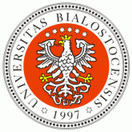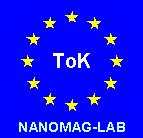Sponsors:





|
|
Organized by
the Institute of Experimental Physics, University of Bialystok
Bogdan Idzikowski
Institute of Molecular Physics, Polish Academy of Sciences, Poznan, Poland
Magnetic order in topological disorder
-
Topological criteria for amorphisation of multicomponent alloys are discussed. A model is proposed for metallic glass formation through destabilization of the host crystalline lattice by substitutional and/or interstitial solute elements. A solute element may partition between substitutional and interstitial sites and the model calculates relative site frequency as a function of the strain energy associated with each site. The strain energy, in turn, depends upon solute and solvent elastic properties and relative sizes, and upon temperature. The crystalline lattice is destabilized, which may lead to amorphization, when solute elements produce a critical internal strain required to change local coordination numbers [1].
For example fully amorphous structures have been found by us in melt-spun alloys from the pseudo-ternary system DyMn6-x-yFex+yGe6-xAlx (x, y = 0 to 6) [2]. During rapid solidification, the amorphous states compete with the nucleation of ternary intermetallic compounds of different crystallographic structures. All amorphous samples exhibit multistep crystallization behavior without a clear indication for a glass transition below the first exothermic effect. Some of the amorphous alloys exhibit a magnetic ordering above room temperature and complex magnetic transitions similar to the properties of crystalline 1-6-6 compounds. The occurrence of glassy states in Dy-(Mn,Fe)6-(Ge,Al)6 cannot be classified by the usual rules developed for the glass-formation ability in multinary amorphous metals. Repulsive interactions between certain alloy components play an important role for the stability of these amorphous structures. This effect requires four or five alloy components within a basic amorphous structure. The results suggest that chemical interactions are important for a refined confusion principle in multinary metallic glass-formers.
Another type of amorphization and then nanocrystallization processes during heat treatment has been observed in NANOPERM-type materials. With increasing temperature of treatment, amorphous Fe41Ni40Zr7B12 alloy undergoes nanocrystallisation with SRO (short range order) close to the fcc-crystal structure [3] . Magnetization of the sample annealed above 582°C for 1 hour becomes enormously sensitive to pressure (that means volume) changes. Even small increase in the annealing temperature e.g. from 582°C to 595°C leads to pronounced magnetovolume phenomena. The pressure induced decrease in magnetization is almost one order of magnitude. This behavior could be comparable with the Invar characteristics of the crystalline Fe67Ni33 alloy. That reflects an abrupt increase in the range of the coherent (crystalline) regions, a qualitative change in their electron structure and a relevant evolution of characteristic behavior of itinerant ferromagnets. In general, the temperature dependencies of magnetic parameters corresponding to nanosized grains deviate from those of a bulk alloy with the same composition. Three mechanisms responsible for the observed effects are proposed: (i) influence of impurities in nanograins, (ii) grains surface contribution (iii) or, most probably, changes in lattice parameters of Cr23C6-type grains. Different magnetic behavior may be observed for low, medium, and high volumetric fraction of crystallites.
Both families of alloys exhibit unusual magnetic behavior in amorphous states as well as after relaxation of glassy structure or after the first stage of crystallization. These problems are also discussed.
[1] A.R. Yavari: "The changing faces of disorder" Nature Mater. 6 (2007) 181
[2] P. Kerschl, U. K. Rößler, T. Gemming, and K.-H. Müller, Z. Sniadecki, B. Idzikowski: "Amorphous states of melt-spun alloys in the system Dy-(Mn,Fe)6-(Ge,Al)6" Appl. Phys. Lett. 90 (2007) 031903
[3] B. Idzikowski, A. Szajek, J.-M. Greneche, J. Kovac: "Nanogranular FexNi23-xB6 phase formation during devitrification of nickel-rich Ni64Fe16Zr7B12Au1 amorphous alloy", Appl. Phys. Lett. 85 (2004) 1392
|
|
|